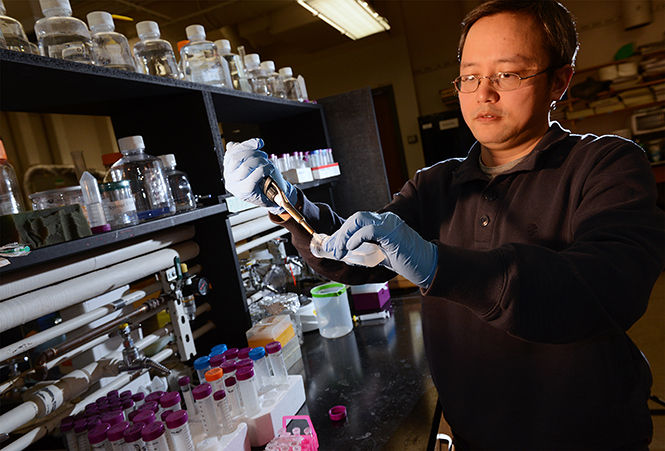Kent State researchers continue work toward preventing cancer
Hanbin Mao, an associate professor in the department of chemistry and biochemistry, demonstrates the process of combining several components in a cuvette test tube, an early stage in telomere research, Monday, March 2, 2015, in Williams Hall. Mao and several graduate students are investigating methods to stop the spreading of telomerase enzymes which often elongate the life of cancer cells.
March 9, 2015
Researchers at Kent State plan to begin the next step in their effort to combat cancer production in human DNA.
Hanbin Mao, associate professor of chemistry and biochemistry, said his team is investigating the telomere region located at the ends of DNA. Telomere structures protect DNA strands from shortening or dying. This protects cells from dying as well.
DNA is where all of an organism’s genetic information is stored, Mao said.
“The goal is to treat the cancer,” said Chiran Ghimire, one of two graduate appointee students working on the project. “Eighty-five percent of cancers grow in the telomere region.”
Mao said that the “enzyme telomerase will improve survivability of the DNA,” which “maintains the immortality” of cancer cells. However, this can change with the introduction of the triple-stranded structures known as tetraplex.
“We try to look at new DNA structures, called tetraplex structures,” Mao said. “The structure may easily enhance or inhibit the cancer gene.”
The project is estimated to conclude Oct. 31, 2017, according to the National Science Foundation’s website. However, the second graduate appointee, Sangeetha Selvam said the team is just beginning to understand the telomere region, opening up the possibilities of mapping out further portions within the region.
Mao, the principal investigator of the project, is assisted by a team of graduate students to research the different DNA structures in the human body to better understand how to stop cancer growth.
Ghimire said he has been working on this project for as a part of his doctorate program.
Before this, Ghimire was working on research on a DNA structure similar to the G-quadruplex known as i-motif (other four stranded structures of DNA) and on lipid droplets. G-quadruplex structures are one-stranded versions of DNA folded over into four-stranded versions of DNA, Selvam said. G-quadruplex structures are present in the telomere region, which is inspiring many researchers to investigate the telomere region.
Selvam said she has been working on the project since she came to Kent State in 2012 for her master’s degree. She started investigating one structure of the telomere region, which later turned into researching the entire region.
“I’m trying to investigate whether that structure can be formed (and) when the cell is constrained,” Selvam said. “I’m trying to investigate in highly constrained situations how G-quadruplex (structures) are formed and what is the mechanical stability behind it.”
Selvam’s works have been published in the Journal of the American Chemical Society, including her work on the “insulin-linked polymorphic region” and G-quadruplexes.
The project has also collaborated with Kyoto University in Japan, with the project led by chemistry professor Hiroshi Sugiyama. The university performed synthesis experiments on the G-quadruplex, Ghimire said.
Contact Jacob Runnels at [email protected].

























